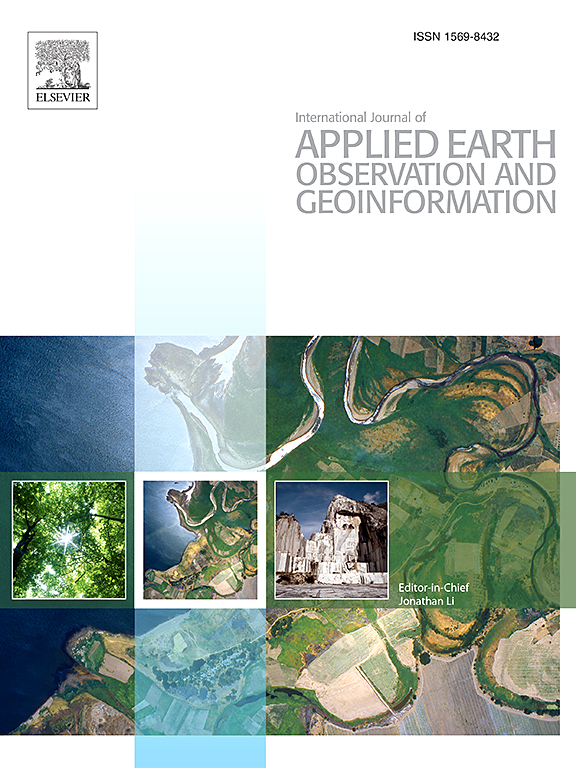A flexible framework for identifying urban villages using Sentinel-2 observations and deep learning
IF 8.6
Q1 REMOTE SENSING
International journal of applied earth observation and geoinformation : ITC journal
Pub Date : 2025-05-28
DOI:10.1016/j.jag.2025.104631
引用次数: 0
Abstract
Identifying urban villages (UVs) is essential for supporting urban renewal and governance, as these informal areas present significant challenges to urban sustainability. Existing multi-modal deep-learning studies have accurately identified UVs in individual cities; however, their scalability is constrained by substantial computational demands and data availability. Currently, efficient deep-learning models tailored for large-scale, consistent UV maps using freely released Sentinel-2 data remain underexplored. Therefore, we proposed a flexible framework leveraging multiple Sentinel-2 observations and deep-learning models to cost-effectively support large-scale UV mapping. We specifically employed a dual-branch encoder to consolidate discriminative features: one branch extracted static information from annual images, while the other captured seasonal dynamics induced by building shadows across four seasonal images. These features were then jointly represented using fusion modules and used for UV identification through skip connections. The model was trained and tested on self-compiled Guangzhou-Shenzhen samples, with the Pearl River Delta serving to analyze applicability and transferability. Results demonstrated incorporating dynamic information notably enhanced the accuracy of UV identification. The proposed framework exhibited optimal performance (mIoU: 83.33 %) with robust spatial generalization, surpassing traditional methods (mIoU improvements: 0.46–12.49 %). Compared to multi-modal data-driven studies, our framework can be conveniently implemented in complex urban environments while maintaining both efficiency and accuracy in large-scale applications. This cost-effective solution offers high-quality, large-scale UV mapping, thereby advancing UV management and planning efforts.
利用Sentinel-2观测和深度学习识别城中村的灵活框架
确定城中村(UVs)对于支持城市更新和治理至关重要,因为这些非正式地区对城市的可持续性构成了重大挑战。现有的多模态深度学习研究已经准确地识别了单个城市的紫外线;然而,它们的可伸缩性受到大量计算需求和数据可用性的限制。目前,利用免费发布的Sentinel-2数据为大规模、一致的UV地图量身定制的高效深度学习模型仍未得到充分开发。因此,我们提出了一个灵活的框架,利用多个Sentinel-2观测和深度学习模型,以经济有效地支持大规模紫外线映射。我们特别采用了双分支编码器来整合判别特征:一个分支从年度图像中提取静态信息,而另一个分支捕获由四个季节图像中的建筑阴影引起的季节性动态。然后使用融合模块联合表示这些特征,并通过跳过连接用于紫外识别。在自编的广州-深圳样本上对模型进行了训练和检验,并以珠三角为样本分析了模型的适用性和可移植性。结果表明,加入动态信息显著提高了紫外识别的准确性。该框架表现出最优的性能(mIoU: 83.33%)和稳健的空间泛化,优于传统方法(mIoU改进:0.46 - 12.49%)。与多模态数据驱动的研究相比,我们的框架可以方便地在复杂的城市环境中实施,同时在大规模应用中保持效率和准确性。这种具有成本效益的解决方案提供高质量,大规模的紫外线映射,从而推进紫外线管理和规划工作。
本文章由计算机程序翻译,如有差异,请以英文原文为准。
求助全文
约1分钟内获得全文
求助全文
来源期刊

International journal of applied earth observation and geoinformation : ITC journal
Global and Planetary Change, Management, Monitoring, Policy and Law, Earth-Surface Processes, Computers in Earth Sciences
CiteScore
12.00
自引率
0.00%
发文量
0
审稿时长
77 days
期刊介绍:
The International Journal of Applied Earth Observation and Geoinformation publishes original papers that utilize earth observation data for natural resource and environmental inventory and management. These data primarily originate from remote sensing platforms, including satellites and aircraft, supplemented by surface and subsurface measurements. Addressing natural resources such as forests, agricultural land, soils, and water, as well as environmental concerns like biodiversity, land degradation, and hazards, the journal explores conceptual and data-driven approaches. It covers geoinformation themes like capturing, databasing, visualization, interpretation, data quality, and spatial uncertainty.
 求助内容:
求助内容: 应助结果提醒方式:
应助结果提醒方式:


